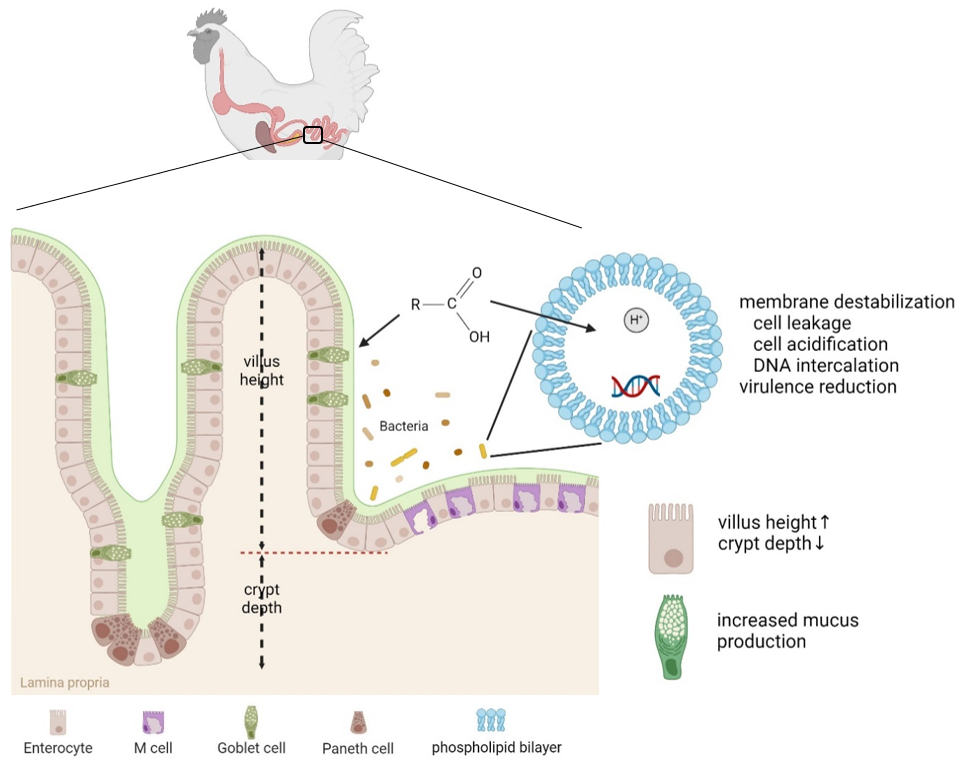Written by David Hermans, Researcher functional ingredients at Agrifirm
Antibacterial and morphological effect of MCFA at gut level
Medium-chain fatty acids (MCFA) are saturated unbranched monocarboxylic acids (from C6 to C12) known for their strong antibacterial and antiviral effects and positive contribution to improved gut morphology (Figure 1). MCFA can destabilize the phospholipid bilayer of bacteria, leading to a cascade of reactions, including: cell membrane destabilization, cell content leakage, cell acidification, and DNA intercalation. This ultimately results in killing-off of the pathogen and boosting poultry health
At concentrations below those that kill bacteria or inhibit bacterial growth, MCFA can reduce the virulence of pathogens by reducing their capacity to form toxins and to adhere to and invade epithelial cells. These antibacterial effects lead to a reduced pathogenic burden on the gut, resulting in a higher villus-to-crypt ratio, which ameliorates digestion and absorption.

Immunomodulatory effects of MCFA beyond gut level
MCFA are also believed to play an important immunomodulatory role in the animal, beyond just the gut, by contributing to boosting poultry health. MCFA (and other fatty acids) act as ligands for free fatty acid receptors (FFARs), which are expressed by several intestinal immune and non-immune cells. Upon binding, a cascade reaction is initiated, leading to improved gut morphology and immune status (through cell activation, proliferation and differentiation, as well as an altered cytokine expression profile and secretion of antimicrobial host peptides) (Melhem et al., 2019).
To date, only the presence of FFAR2 has been verified in the chicken’s genome, although the existence of other FFARs in poultry cannot be excluded (Mielenz, 2017). FFAR2 has a preference for shorter chain fatty acids (C2 – C6). Its ubiquitous expression on epithelial (Figure 1) and immune cells indicates this receptor’s (and its ligands’) important role in steering the immune system, which is a complex network of organs, cells and proteins that defends the body against infection while protecting host cells.
Generally, the immune system is made up of two parts: the innate and adaptive immune system.
Innate (or natural, native) immunity provides the first line of defense and is characterized by an early, rapid and non-specific response against infection. Phagocytic white blood cells, such as heterophils, are key during the innate immune response. They are the first to arrive at the site of inflammation, where they mount a response to pathogens and produce cytokines and chemokines to coordinate the recruitment and activation of other immune cells. MCFA interact with these cells through FFARs, whose expression is triggered particularly during an LPS challenge – e.g., when there is a bacterial infection.
Antigen-presenting cells, such as dendritic cells, process antigenic material and present it on the cell surface to T lymphocytes. As such, these cells are crucial in the communication between the innate and the adaptive (or acquired, specific) immune system. The latter is activated when innate mechanisms fail to eliminate a pathogen. This immune response is more delayed, can be augmented by repeated exposure to the same antigen (which is the vaccination principle), and has a memory function.
- Cellular immunity
MCFA may modulate the adaptive mechanism of defense through direct interaction with T cells (= cellular immunity). Recently, Agrimprove has gathered a significant amount of data proving this hypothesis. In a study with chicken peripheral blood mononuclear cells (PBMC), an increased proliferation rate of total T cell populations and an increased proportion of cytotoxic (CD8+) T cells – which are responsible for clearing infected host cells – was observed after treatment with C-prove 80 and S-prove. - Humoral immunity
Adding C-prove 80 to the broiler chicken’s drinking water showed an increase in specific antibody titers (= humoral immunity) against infectious bursal disease (IBD) after IBD vaccination. This observation indicates that there is a possible effect of C6 on (antibody-producing) B lymphocytes, either directly or indirectly through the activation of T helper (CD4+) cells, which may increase vaccine efficiency.
In addition, when S-prove was added to the diet of broiler chickens, we observed several potential downstream effects of immune cell modulation, such as reduced jejunal expression of the pro-inflammatory cytokine IL-6. The immunomodulatory effects of MCFA are not limited to the gut, as we observed an increase in β-defensin 9 production in the spleen upon feeding S-prove to birds.
Conclusion
To conclude, these observations point toward an important immunomodulatory role of C6, aiding in disease resilience while also improving animal performance and boosting poultry health. By acting on lymphocytes, a faster and more efficient immune response to infectious diseases can be expected and a detrimental over-activation of the innate immune response can be prevented.